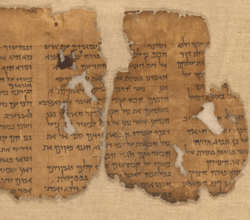Habakkuk 3
| Habakkuk 3 | |
|---|---|
 The beginning of Habakkuk Commentary, 1QpHab, among the Dead Sea Scrolls from the 1st century BC. | |
| Book | Book of Habakkuk |
| Bible part | Old Testament |
| Order in the Bible part | 35 |
| Category | Nevi'im |
Habakkuk 3 is the third (and the last) chapter of the Book of Habakkuk in the Hebrew Bible or the Old Testament of the Christian Bible.[1][2] This book contains the prophecies spoken by the prophet Habakkuk, and is a part of the Book of the Twelve Minor Prophets.[3][4] This chapter records "Habakkuk's song", a poetic psalm "extolling God's triumphs."[5]
Text
- The original text is written in Hebrew.
- This chapter is divided into 19 verses.
Textual version
Some most ancient manuscripts containing this chapter in Hebrew language:[6]
- Masoretic Text
- Codex Cairensis (895 CE)
- Aleppo Codex (10th century)
- Leningrad Codex (1008-1009)
Ancient translations in Koine Greek:
- Septuagint (different verse numbering)
- Theodotion version
Structure
NKJV groups this chapter into:
- Habakkuk 3:1 = Title
- Habakkuk 3:2-16 = The Prophet’s Prayer
- Habakkuk 3:17-19 = A Hymn of Faith
Verse 1
- A prayer of Habakkuk the prophet upon Shigionoth. (KJV)[7]
Verse 19
- The Lord God is my strength, and he will make my feet like hinds' feet,
- and he will make me to walk upon mine high places.
- To the chief singer on my stringed instruments. (KJV)[10]
- יהוה אדני חילי וישם רגלי כאילות ועל במותי ידרכני למנצח בנגינותי׃
Transliteration:
- YHWH a·do·nai khi·li wai·ya·syem rag·lai ka·'ai·ya·lot
- we·'al ba·mo·tai yad·ri·khe·ni
- lam·na·tze·akh bin·gi·no·tai.<ref>Habakkuk 3:19 in Hebrew - Biblehub]
Verse 19 note
- The phrase "make my feet like hinds' feet" is similar to the phrases in Psalm 18:33 or 2 Samuel 22:34
- The last word of the verse (and of the Book of Habakkuk) נגינותי׃, neginotai is translated as "my stringed instruments", originally from plural form of the Hebrew word נְגִינַת, neginath, which is also found in the beginning of some psalms, namely Psalm 4; Psalm 6; Psalm 54; Psalm 55; Psalm 67; Psalm 76.[11][12]
Discussion
Some scholars suggest that Chapter 3 may be a later independent addition to the book,[13] in part because it is not included among the Dead Sea Scrolls. However, this chapter does appear in all copies of the Septuagint, as well as in texts from as early as the 3rd century BC.[13] This final chapter is a poetic praise of God, and has some similarities with texts found in the Book of Daniel. However, the fact that the third chapter is written in a different style, as a liturgical piece, does not necessarily mean that Habakkuk was not also its author.[14] Its omission from the Dead Sea Scrolls is attributed to the inability of the Qumran sect to fit Habakkuk's theology with their own narrow viewpoint.[15]
See also
Bibliography
- Baker, David W. (1988). Nahum, Habakkuk and Zephaniah. Tyndale Old Testament Commentaries. Downers Grove, IL: Inter-Varsity Press. ISBN 0-87784-249-3.
- Brown, Francis; Briggs, Charles A.; Driver, S. R. (1994). The Brown-Driver-Briggs Hebrew and English Lexicon (reprint ed.). Hendrickson Publishers. ISBN 978-1565632066.
- Collins, John J. (2014). Introduction to the Hebrew Scriptures. Fortress Press.
- Cross, F. L. & Livingston, E. A., eds. (2005). The Oxford Dictionary of the Christian Church (3rd ed.). New York: Oxford University Press. ISBN 0-19-280290-9.
- Gesenius, H. W. F. (1979). Gesenius' Hebrew and Chaldee Lexicon to the Old Testament Scriptures: Numerically Coded to Strong's Exhaustive Concordance, with an English Index. Translated by Tregelles, Samuel Prideaux (7th ed.). Baker Book House.
- Hayes, Christine (2015). Introduction to the Bible. Yale University Press.
- Széles, Mária Eszenyei (1987). Wrath and Mercy: A Commentary on the Books of Habakkuk and Zephaniah. International Theological Commentary. trans. George A. F. Knight. Grand Rapids, MI: Wm. B. Eerdmans. ISBN 0-8028-0242-7.
References
- ↑ Collins 2014.
- ↑ Hayes 2015.
- ↑ Metzger, Bruce M., et al. The Oxford Companion to the Bible. New York: Oxford University Press, 1993.
- ↑ Keck, Leander E. 1996. The New Interpreter's Bible: Volume: VII. Nashville: Abingdon.
- ↑ The New Oxford Annotated Bible with the Apocrypha, Augmented Third Edition, New Revised Standard Version, Indexed. Michael D. Coogan, Marc Brettler, Carol A. Newsom, Editors. Publisher: Oxford University Press, USA; 2007. p. 1344 Hebrew Bible. ISBN 978-0195288810
- ↑ Würthwein, Ernst (1995). The Text of the Old Testament. Fortress press. ISBN 0-8028-0788-7.
- ↑ Habakkuk 3:1
- ↑ Brown, 1994 & "שִׁגָּיוֹן".
- ↑ Gesenius, 1979 & "שִׁגָּיוֹן".
- ↑ Habakkuk 3:19
- ↑ Brown, 1994 & "נְגִינַת".
- ↑ Gesenius, 1979 & "נְגִינַת".
- 1 2 Baker (1988), p. 46.
- ↑ Cross (2005).
- ↑ Széles (1987), p. 9.
External links
| Wikisource has original text related to this article: |
| Look up Habakkuk in Wiktionary, the free dictionary. |
- Historic manuscripts
- The Commentary on Habakkuk Scroll, The Digital Dead Sea Scrolls, hosted by the Israel Museum, Jerusalem.
- Jewish translations
- Chavakuk – Habakkuk (Judaica Press) translation [with Rashi's commentary] at Chabad.org
- Christian translations
- Online Bible at GospelHall.org (ESV, KJV, Darby, American Standard Version, Bible in Basic English)

- Further information
- A Brief Introduction to The Prophecy of Habakkuk for Contemporary Readers (Christian Perspective)
- Introduction to the book of Habakkuk from the NIV Study Bible
- Introduction to the Book of HabakkukForward Movement Publications